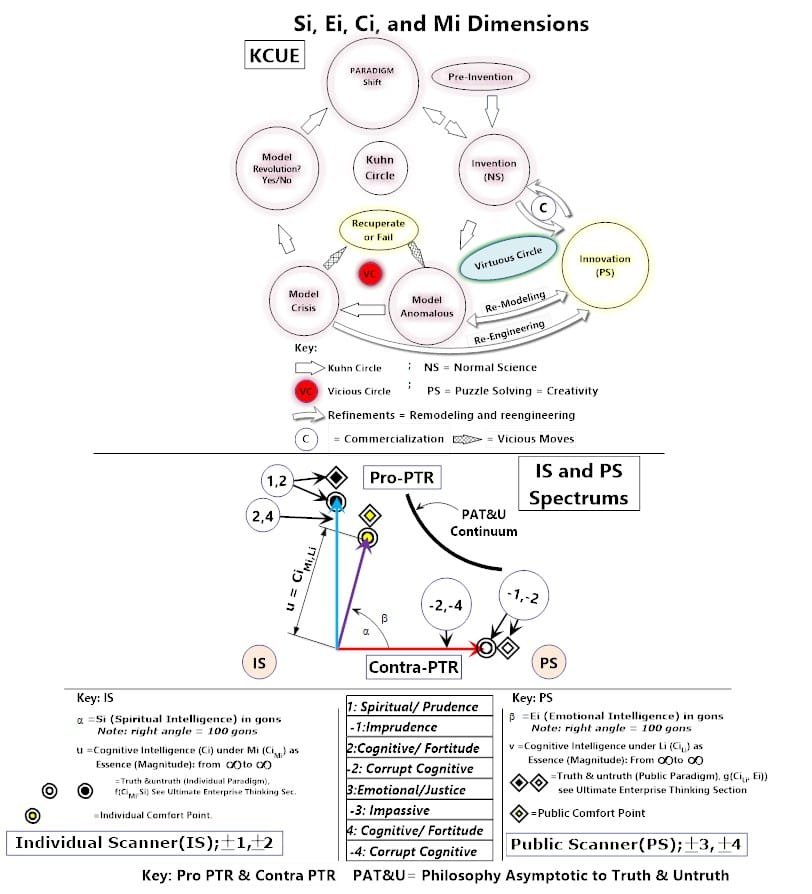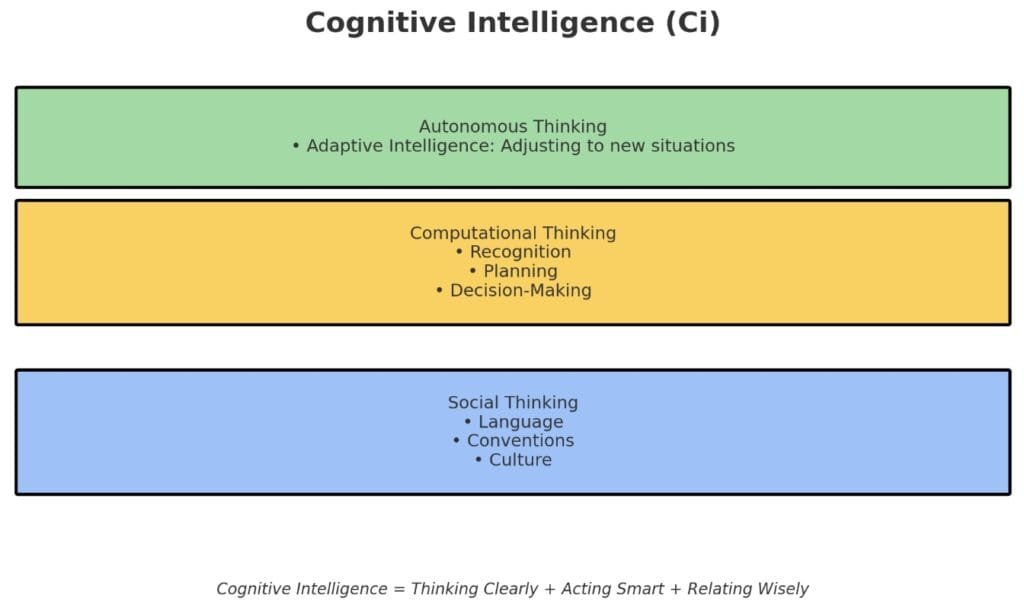Unlock the Power of Your Inner Intelligence: Si, Ei, Ci & Mi (Personality)
Welcome to the core of human potential—where science meets spirit, and your journey toward personal mastery begins as personal abilities. At Spiralinfluensa, we believe success doesn’t start with hustle—it starts with inner intelligence. We’ve identified four powerful dimensions that shape your reality:
- 🌌 Spiritual Intelligence (Si) – Your compass to truth, purpose, and transcendence.
- 💖 Emotional Intelligence (Ei) – The engine of self-awareness, empathy, and resilience.
- 🧠 Cognitive Intelligence (Ci) – The logic, reasoning, and insight that power innovation.
- ⚖️ Moral Intelligence (Mi) – The ethical backbone guiding your decisions and values.
These Personality Abilities—also known as Intelligence Dimensions—are the inner forces behind everything you do. They don’t just influence your mindset… they determine your impact.
Figure-1: Personality Abilities (Personality Intelligence Dimensions)
KCUE (Kuhn-Circle Ultimate Enterprise) has powerful circles that arise from Kuhn-Circle, namely virtuous and vicious circles. As shown in Figure 1, the virtuous and vicious circles create the dimensions based on their areas of competency, as shown in the above KCUE figure (Si, Ei, Ci, and Mi dimensions). The lower figure IS and PS Spectrums is used to locate the stage on the above figure. The IS and PS diagrams are integrated into a single picture for clarity, while vicious and virtuous circles are assembled in a well-known Kuhn circle.

🚀 What Makes This System Different (Personality)?
Our model is powered by the revolutionary KCUE Framework (Kuhn-Circle Ultimate Enterprise), rooted in the virtuous vs. vicious circles of life. Your spiritual and emotional intelligences steer your direction, while cognitive and moral intelligences fuel your journey. Think of it like this:
- Si + Ei = Direction 🔀
- Ci + Mi = Acceleration 🚀
Together, they create unstoppable momentum. Our dynamic IS (Individual Spectrum) and PS (Public Spectrum) reveal exactly where you are on your growth path—emotionally, spiritually, intellectually, and ethically.
✨ Are You Ready to Awaken (Personality)?
Each intelligence has powerful layers—dimensions that unlock high-level competencies. For example:
- Spiritual Intelligence empowers you through:
- Consciousness
- Existential Clarity
- Transcendence
- Sanctity
- Emotional Intelligence sharpens your:
- Self-Awareness
- Self-Management
- Social-Awareness
- Relationship Mastery
And this is just the beginning… download an eBook for details
🔓 The Future Belongs to the Self-Aware (Personality)
In an era where attention is currency, your inner intelligence is your greatest asset. Whether you’re leading a team, building a brand, or transforming your life—knowing who you are and how you think is your shortcut to growth. Explore the full model, download the insights, and join a movement of purpose-driven achievers at [www.spiralinfluensa.com] (http://www.spiralinfluensa.com). Your breakthrough is not outside you—it starts within. 🌱
I hope this helps you understand the concept of inner intelligence and its dimensions. If you have any specific questions or need further details, feel free to ask! 😊
Brief amplifications
Emotional Intelligence:
Table 1: Framework of Emotional Competencies (courtesy of Daniel Goleman)
| Self: Personal Competence | Other: Social Competence | |
|---|---|---|
| Recognition | Self-Awareness: Emotional self-awareness, Accurate self-assessment, Self-confidence | Social Awareness: Empathy, Service orientation, Organizational awareness |
| Regulation | Self-Management: Self-control, Trustworthiness, Conscientiousness, Adaptability, Achievement drive, Initiative | Relationship Management: Developing others, Influence, Communication, Conflict management, Leadership, Change catalyst, Building bonds, Teamwork & collaboration |
Some brief description
Self-Competence
This focuses on your ability to understand and manage yourself effectively. It includes:
- Self-Awareness: Knowing your emotions, strengths, weaknesses, and values. For example, being aware of what makes you stressed or confident.
- Self-Management: Regulating your emotions and behaviors to adapt and achieve goals. This could involve staying calm under pressure, maintaining integrity, or taking the initiative to address challenges.
Essentially, self-competence is about being in tune with yourself and harnessing that awareness to navigate life’s ups and downs in a purposeful way.
Social Competence
This is your ability to understand and manage interactions with others. It includes:
- Social Awareness: Recognizing and understanding the emotions, needs, and concerns of others. Empathy plays a key role here, as does being attuned to group dynamics or social settings.
- Relationship Management: Building and maintaining positive connections. It involves skills like effective communication, conflict resolution, teamwork, and inspiring or leading others toward a shared goal.
In short, social competence is about navigating and nurturing relationships while being sensitive to the perspectives and emotions of those around you.
Together, these two dimensions form the foundation of emotional intelligence, enabling individuals to thrive personally and socially.
Cognitive Intelligence:
Cognitive Intelligence is essentially our brain’s ability to think clearly, solve problems, learn new things, and make smart decisions. It’s how we understand the world, adapt, and interact with others. Here are the three dimensions of Cognitive Intelligence explained in a more relatable way:
Autonomous Thinking
This is your brain’s ability to think for itself and adapt. Imagine it as mental flexibility—staying calm and creative in new or difficult situations. For example, figuring out how to work from home during a power outage shows adaptive intelligence.
Computational Thinking
This involves analyzing, planning, and making decisions. It’s like having a mental toolkit for recognizing patterns, setting goals, and choosing the best options. For instance, spotting when someone’s upset even if they say they’re “fine” demonstrates recognition skills. Creating a study plan before exams or mapping out a fitness routine showcases planning abilities. Deciding between two job offers by weighing pros and cons is an example of decision-making.
Social Thinking
This is your brain’s toolkit for working with people. It includes using language to communicate thoughts, feelings, and ideas clearly, knowing and following social rules and norms, and understanding how people’s beliefs, values, and customs shape behavior. For example, explaining a complex idea in a simple way during a team meeting shows language skills. Saying “thank you,” shaking hands, or dressing appropriately for a formal event demonstrates conventions. Respecting silence as a sign of politeness in one culture while recognizing directness as respectful in another illustrates cultural understanding.
Why It Matters
Cognitive Intelligence helps us solve everyday problems, think critically and logically, navigate both solo tasks and social situations, communicate effectively across cultures, and make informed choices in uncertain or changing environments.
Visual Diagram of Ci
Here’s a visual diagram of Cognitive Intelligence (Ci) made user-friendly and clear. It breaks Ci into three core areas:
- Autonomous Thinking – Being able to adapt to new challenges.
- Computational Thinking – Recognizing problems, planning ahead, and making decisions.
- Social Thinking – Using language, following norms, and understanding culture.

Moral Intelligence.
Moral Intelligence (Mi) is the principles and values controlling reasoning, divided into ethics and aesthetics. We identify Moral Intelligence (Mi) by three dimensions: decision-Making, judgment, and Inference. These dimensions, when scribed in a Venn diagram and rename the disconnect between the adjacent, we get further competencies as summarized in a Moral raw as Three Dimensions of Moral Cognition (courtesy of Hongbo Yu et al 26
Disconnecting between moral judgement and moral decision-making is Moral Hypocrisy. Disconnect between moral judgement and moral Inference is personal-centered Centered Morality. And the disconnect between moral inference and moral decision-making is Moral Hypocrisy.
brief definition of terms for the courtesy of Hongbo Yu et al.
Moral Decision-making
Moral decision-making: “how people make decisions that affect the welfare of others.” by Hongbo Yu et al. The following competencies are necessary to achieve the moral decision-making dimension:
- Problem rationalization
Problem rationalization “Know the problem you are solving.” Peter Drucker
- Boundary conditions
The definition of the specifications that the answer to the problem has to satisfy, of the “boundary conditions.” Know your range of options that will still count as success. Peter Drucker
- Right thing to do
Before you decide what’s workable, first figure out what the right thing to do is.–Peter Drucker
- Action
Turn decisions into action. – Peter Drucker
- Feedback
Get feedback on what’s working and what’s not. –Peter Drucker
Moral judgment
Moral judgment: “how people make judgments about the moral appropriateness of actions and assign blame and punishment, or praise and reward.” by Hongbo Yu et al. The following competencies help to achieve the judgment dimension:
Moral inference
Moral inference: how people form beliefs about the moral character of agents based on observations of morally relevant behaviors. – by Hongbo Yu et al. The following competencies are necessary to achieve the moral inference dimension:
Moral Inference Competencies.
- Information: it is background knowledge about what we have to infer. “Background knowledge by reading, talking to people, traveling, watching the news, learning job skills—in fact, everything we have seen and done contributes to our background knowledge.” 27
- Assumptions: they are guiding attitudes on the cause of inference, mainly arising from standing beliefs. For example, consider solutions to poverty in a third-world country. Two or more consultants may differ on inferences based on their attitudes, like lack of leadership or lack of management. Such an assumption offers different inferences.
- Implications: “Not all inferences are based on facts. We often make inferences based on a best guess or on implications. When a statement is only suggested or hinted at, it is an implication. We draw inferences and reach conclusions from implications just as we do from direct statements. The problem with drawing conclusions from implications is that the language of implications is slippery, sometimes intentionally so.” courtesy of butte.edu.
- Connotation: “one reason we can make implications is that words have connotation. Denotation is the dictionary meaning of a word. Connotation is its ‘color’ or emotional feel. Some words have negative connotations, some positive. Would you rather be called sensitive or touchy? Liberal or progressive? Religious or spiritual? We interpret connotation unconsciously, making inferences about both the author and material based partly on the ‘color’ of the words. Connotation is cultural.” courtesy of butte.edu.
Moral Common Fallacies
As we can see in Table 4, the intersections of the Venn diagram in Three Dimensions of Moral Cognition (thanks to Hongbo Yu et al.) show three common errors or lies in inference. These are moral hypocrisy, moral influence, and personal-centered morality, which we will talk about below.
Moral hypocrisy is the “motivation to appear moral while, if possible, avoiding the cost of being moral. This opposes moral integrity, which is the motivation to act in accord with moral principles—to be moral.” 28
Moral influence can be understood as an interaction between moral inference and moral decision-making, and
Personal-centered Morality: focusing on individuals as the unit of analysis for moral evaluations rather than on acts.
We can put together all the intelligence dimensions and competencies in a table below.
Summary of Intelligences Dimensions
Table 2: Summary of Intelligence Dimensions
| Intelligence | Abilities (Dimensions) with Competencies | |||||
| 1st | 2nd | 3rd | 4th | |||
| Spiritual | Consciousness· Awareness· Wakefulness | Existential· Self-awareness· Freedom & Responsibility· Identity· Meaning, values· Anxiety· Death & nonbeing | Transcendence (Transliminality)· Magical Ideation· Mystical Experience· Ineffability· Noetic quality· Transiency· Passivity· Absorption· Hyperaesthesia· Manic Experience· Dream Interpretation· Fantasy Proneness | Sanctity· Care/harm· Fairness/cheating· Loyalty/betrayal· Authority/subversion· Sanctity/degradation· Liberty/oppression | ||
| Emotional | Self-Awareness· Emotional self-awareness· Accurate self-awareness· Self-confidence | Self-Management· Self-control· Trustworthiness· Conscientiousness· Adaptability· Achievement drive· Initiative | Social-Awareness· Empathy· Service orientation· Organizational awareness | Relationship-Management· Developing others· Influence· Communication· Conflict management· Leadership· Change catalyst· Building bonds· Teamwork & collaboration | ||
| Cognitive | Autonomous· Adaptive Intelligence | Computational· Recognition· Planning· Decision making | Social· Language· Conventions· Culture | |||
| Moral | Decision-Making· Problem rationalization· Boundary conditions· Right thing to do· Action· Feedback | Judgement· Learning· Trust· Experience· Detachment· Options· Delivery | Inference· Information· Assumptions· Implications· Connotation | Decision-Making· Problem rationalization· Boundary conditions· Right thing to do· Action· Feedback | ||
| Moral Hypocrisy | Personal-Centered Morality | Moral Influence | ||||
